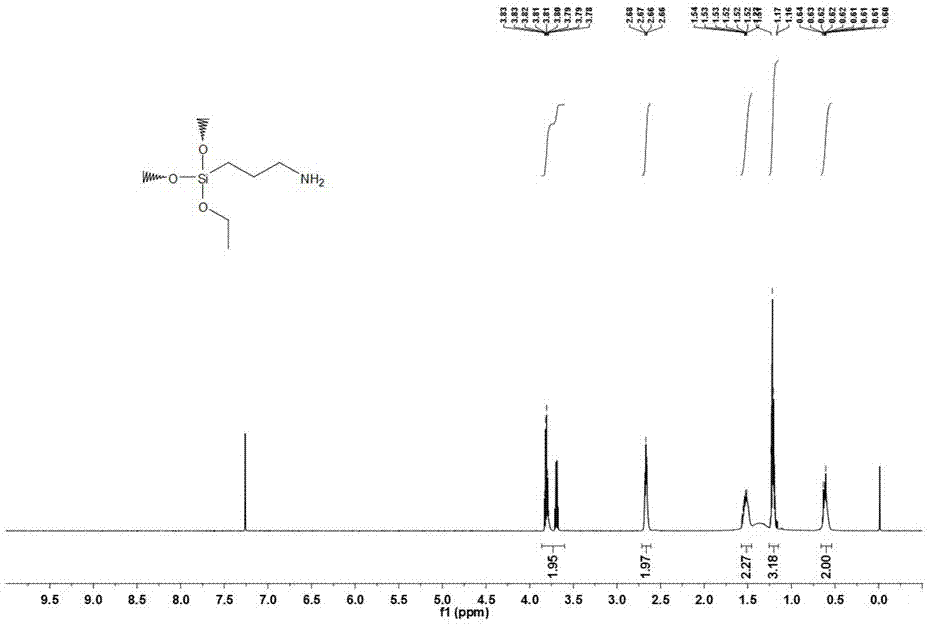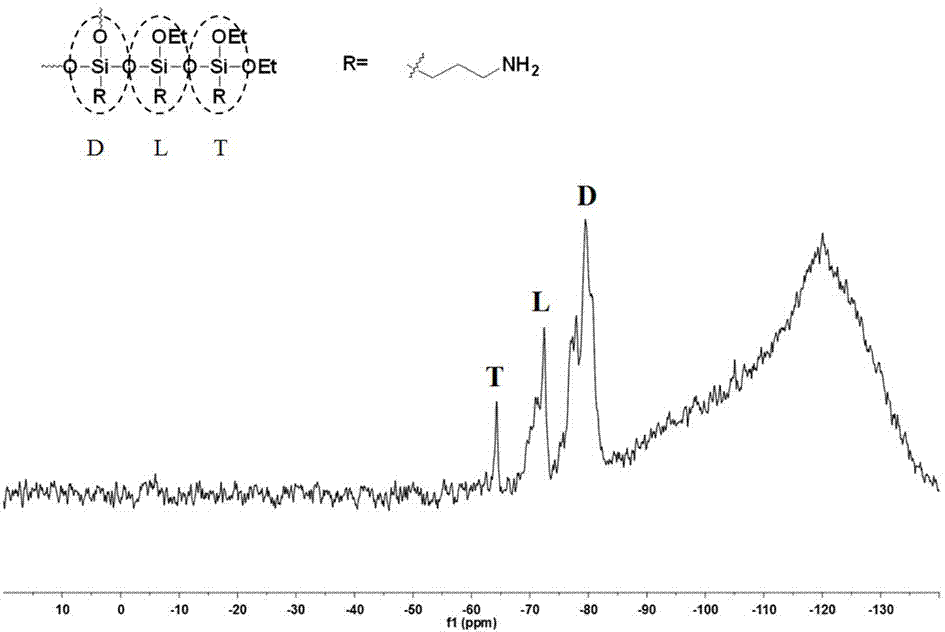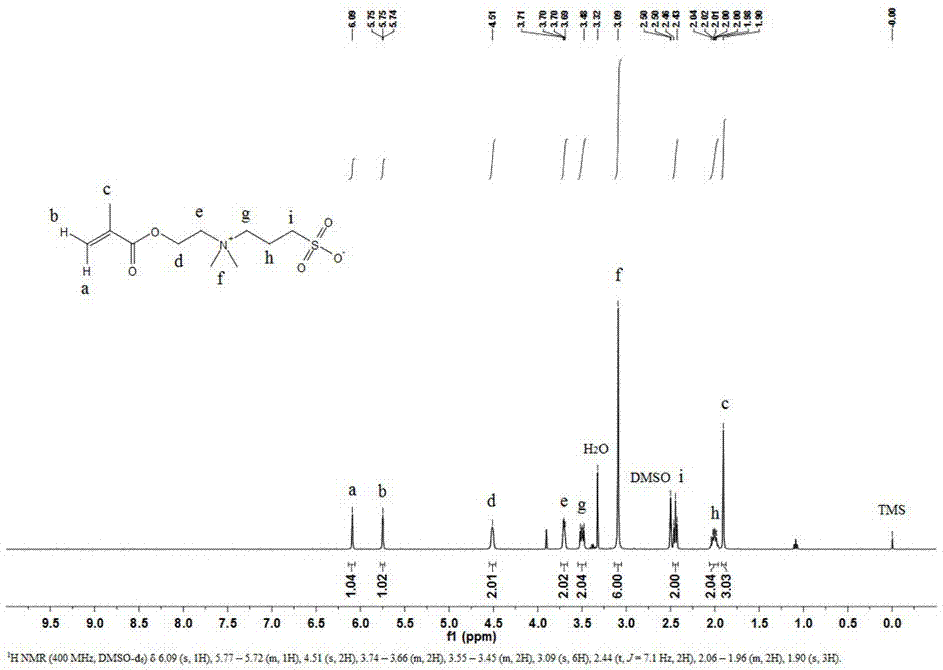Reversible self-repair antibacterial acrylic coating and preparation and self-repair methods
A self-healing, acrylic technology, applied in coatings, antifouling/underwater coatings, paints containing biocides, etc. Good performance, good manufacturability and environmental protection characteristics, the effect of less chain entanglement
- Summary
- Abstract
- Description
- Claims
- Application Information
AI Technical Summary
Problems solved by technology
Method used
Image
Examples
Embodiment 1
[0039] 1) Preparation of hyperbranched polysiloxane (referred to as HPSi) containing amino groups at the end
[0040] Under nitrogen protection, 44.0g of γ-aminopropyltriethoxysilane (KH550) and 4.3g of water were dissolved in 40.0mL of ethanol and reacted at 60°C for 4h. After the obtained solution was cooled to room temperature, the alcohol solvent was distilled off to obtain a colorless liquid, i.e. hyperbranched polysiloxane (HPSi) containing amino groups at the end. For its hydrogen NMR spectrum and silicon NMR spectrum, please refer to the attached figure 1 and 2 .
[0041] 2) Preparation of sulfonyl betaine methacrylate
[0042] At room temperature, dissolve 15.7g of 2-(dimethylamino)ethyl methacrylate and 12.2g of 1,3-propane sultone in 100mL of 1,2-dichloroethane and stir evenly, then raise the temperature to 60°C and continue the reaction for 3h . The resulting mixed solution was cooled to room temperature and then filtered to obtain a white powder, i.e. sulfonyl...
Embodiment 2
[0063] 1) Preparation of hyperbranched polysiloxane (referred to as HPSi) containing amino groups at the end
[0064] Under the protection of argon, 44.0g of γ-aminopropyltriethoxysilane (KH550) and 4.3g of water were dissolved in 40.0mL of ethanol and reacted at 60°C for 4h. After the resulting solution was cooled to room temperature, the alcohol solvent was distilled off to obtain a colorless liquid, namely hyperbranched polysiloxane (HPSi) containing amino groups at the end.
[0065] 2) Preparation of sulfonyl betaine methacrylate
[0066] At room temperature, dissolve 15.7g of 2-(dimethylamino)ethyl methacrylate and 13.4g of 1,3-propane sultone in 100mL of 1,2-dichloroethane and stir evenly, then raise the temperature to 60°C and continue the reaction for 3h . The resulting mixture was cooled to room temperature and then filtered to obtain a white powder, namely sulfonyl betaine methacrylate.
[0067] 3) Preparation of linear acrylic resin containing sulfonyl betaine
...
Embodiment 3
[0075] 1) Preparation of hyperbranched polysiloxane (referred to as HPSi) containing amino groups at the end
[0076] Under the protection of a mixed gas of nitrogen and argon, 44.0g of γ-aminopropyltriethoxysilane (KH550) and 4.3g of water were dissolved in 40.0mL of ethanol and reacted at 60°C for 4h. After the resulting solution was cooled to room temperature, the alcohol solvent was distilled off to obtain a colorless liquid, namely hyperbranched polysiloxane (HPSi) containing amino groups at the end.
[0077] 2) Preparation of sulfonyl betaine methacrylate
[0078] At room temperature, dissolve 15.7g of 2-(dimethylamino)ethyl methacrylate and 15.0g of 1,3-propane sultone in 100mL of 1,2-dichloroethane and stir evenly, then raise the temperature to 60°C and continue the reaction for 3h . The resulting mixture was cooled to room temperature and then filtered to obtain a white powder, namely sulfonyl betaine methacrylate.
[0079] 3) Preparation of linear acrylic resin co...
PUM
| Property | Measurement | Unit |
|---|---|---|
| thickness | aaaaa | aaaaa |
| tenacity | aaaaa | aaaaa |
| glass transition temperature | aaaaa | aaaaa |
Abstract
Description
Claims
Application Information
 Login to View More
Login to View More - R&D
- Intellectual Property
- Life Sciences
- Materials
- Tech Scout
- Unparalleled Data Quality
- Higher Quality Content
- 60% Fewer Hallucinations
Browse by: Latest US Patents, China's latest patents, Technical Efficacy Thesaurus, Application Domain, Technology Topic, Popular Technical Reports.
© 2025 PatSnap. All rights reserved.Legal|Privacy policy|Modern Slavery Act Transparency Statement|Sitemap|About US| Contact US: help@patsnap.com



